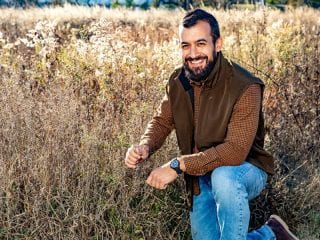USDA Awards $650,000 to Develop Invasive Species Detection System
 Globally, invasive species cause an estimated $423 billion in damage every year, particularly to agricultural production and biodiversity, and these damages are only expected to increase as climate change worsens.
Globally, invasive species cause an estimated $423 billion in damage every year, particularly to agricultural production and biodiversity, and these damages are only expected to increase as climate change worsens.
Detecting invasive species early, before they become established, and simultaneously quantifying their impacts on humans and the environment can both inform and motivate rapid management responses.
Toward that end, the United States Department of Agriculture awarded $650,000 to a team of researchers to develop a better national-scale early detection and rapid response tool. Caleb Roberts, a U.S. Geological Survey research ecologist at the Arkansas Cooperative Fish & Wildlife Research Unit, based in the U of A’s Biological Sciences Department, will serve as the principal investigator.
“As a test species, we are using cogongrass, an invasive grass that was first recorded in southeastern Arkansas in 2021,” Roberts explained. ”Cogongrass has been called the ‘seventh worst weed in the world’ and is known to reduce timber production, increase wildfire risk due to its high flammability and negatively impact biodiversity due to its thick, mat-forming growth pattern.”
Roberts noted that generally the best way to deal with invasive species is prevention through early detection, which means if you know what kind of soil, climate or ground cover a species likes, you should be able to predict where it might invade next. But invasive species are characterized by their ability to move and change their relationship with their environment, so passively waiting for something like cogongrass to show up can leave you a step slow — and by then it may be established and much harder to eradicate.
As such, Roberts and his collaborators are developing a new approach to improve early detection of invasive plants that combines elements of population modeling, genetics, spatial modeling and remote sensing to predict where and when invasive plants will root—essentially creating current and future maps of invasive species’ spread. The end result will be a clear workflow using different statistical techniques that better models where the invasive species is and where it could be in the future.
“We also want to know how it’s going to impact the things that we care about,” Roberts added. “This means the ecosystem services that we care about.”
They don’t just want to know where cogongrass will be, but also want to have an idea of how it will impact biodiversity or increase the chance of fire risk.
“Those are things that people tend to tangibly care about,” Roberts continued. ”So it’s also a motivating tool, right? So that’s why we’re generating this workflow. It hasn’t really been consistent throughout the US.”
By synergizing early detection models and ecosystem service impacts, the team hopes to empower stakeholders and private landowners to prioritize proactive management actions at local, regional and national scales and maximally conserve ecosystem services like biodiversity, timber and livestock production.
Roberts will be joined by research ecologists Devan A. McGranahan and Carissa L. Wonkka, both with the USDA Agricultural Research Service; Victoria M. Donovan, an assistant professor at the University of Florida; and Hsiao-Hsuan Wang, a senior research scientist at Texas A&M University.
About the University of Arkansas: As Arkansas’ flagship institution, the U of A provides an internationally competitive education in more than 200 academic programs. Founded in 1871, the U of A contributes more than $2.2 billion to Arkansas’ economy through the teaching of new knowledge and skills, entrepreneurship and job development, discovery through research and creative activity while also providing training for professional disciplines. The Carnegie Foundation classifies the U of A among the few U.S. colleges and universities with the highest level of research activity. U.S. News & World Report ranks the U of A among the top public universities in the nation. See how the U of A works to build a better world at Arkansas Research and Economic Development News.
This story also appeared in the University of Arkansas News publication.

